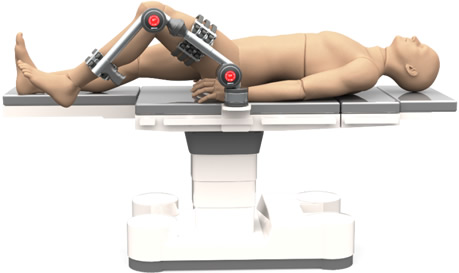Robotic Orthopedic Surgery in India
What is Robotic Orthopedic Surgery ?
Robotic surgery, computer-assisted surgery, and robotically-assisted surgery are terms for technological developments that use robotic systems to aid in surgical procedures. Robotically-assisted surgery was developed to overcome the limitations of pre-existing minimally-invasive surgical procedures and to enhance the capabilities of surgeons performing open surgery.
The term "hallux valgus" or "hallux abducto-valgus" are the most commonly used medical terms associated with a bunion anomaly, where "hallux" refers to the great toe, "valgus" refers to the abnormal angulation of the great toe commonly associated with bunion anomalies, and "abductus/-o" refers to the abnormal drifting or inward leaning of the great toe towards the second toe, which is also commonly associated with bunions. It is important to state that "hallux abducto" refers to the motion the great toe moves away from the body's midline. Deformities of the lower extremity are usually named in accordance to the body's midline, or the line bisecting the body longitudinally into two halves. In more severe cases, the hallux continuing in the abductus fashion eventually either overlaps or underlaps subsequent lesser (small) toes especially the second (adjacent toe).
Comparison to traditional methods
Major advances aided by surgical robots have been remote surgery, minimally invasive surgery and unmanned surgery. Due to robotic use, the surgery is done with precision, miniaturization, smaller incisions; decreased blood loss, less pain, and quicker healing time. Articulation beyond normal manipulation and three-dimensional magnification helps resulting in improved ergonomics. Due to these techniques there is a reduced duration of hospital stays, blood loss, transfusions, and use of pain medication.
Uses
General surgery
In early 2000 the field of general surgical interventions with the daVinci device was explored by surgeons at Ohio State University. Reports were published in esophageal and pancreatic surgery for the first time in the world and further data was subsequently published by Horgan and his group at the University of Illinois and then later at the same institution by others.
Cardiothoracic surgery
Robot-assisted MIDCAB and Endoscopic coronary artery bypass (TECAB) operations are being performed with the Da Vinci system. Mitral valve repairs and replacements have been performed. The Ohio State University, Columbus has performed CABG, mitral valve, esophagectomy, lung resection, tumor resections, among other robotic assisted procedures and serves as a training site for other surgeons. In 2002, surgeons at the Cleveland Clinic in Florida reported and published their preliminary experience with minimally invasive "hybrid" procedures. These procedures combined robotic revascularization and coronary stenting and further expanded the role of robots in coronary bypass to patients with disease in multiple vessels. Ongoing research on the outcomes of robotic assisted CABG and hybrid CABG is being done.
Robotic Surgery

Signs and symptoms
The symptoms of bunions include irritated skin around the bunion, pain when walking, joint redness and pain, and possible shift of the big toe toward the other toes. Blisters may form more easily around the site of the bunion as well.
Having bunions can also make it more difficult to find shoes that fit properly; bunions may force a person to have to buy a larger size shoe to accommodate the width the bunion creates. When bunion deformity becomes severe enough, the foot can hurt in different places even without the constriction of shoes because it then becomes a mechanical function problem of the forefoot.
Cardiology and electrophysiology
The Stereotaxis Magnetic Navigation System (MNS) has been developed to increase precision and safety in ablation procedures for arrhythmias and atrial fibrillation while reducing radiation exposure for the patient and physician, and the system utilizes two magnets to remotely steerable catheters. The system allows for automated 3-D mapping of the heart and vasculature, and MNS has also been used in interventional cardiology for guiding stents and leads in PCI and CTO procedures, proven to reduce contrast usage and access tortuous anatomy unreachable by manual navigation.
removing the abnormal bony enlargement of the first metatarsal,
realigning the cartilagenous surfaces of the great toe joint,